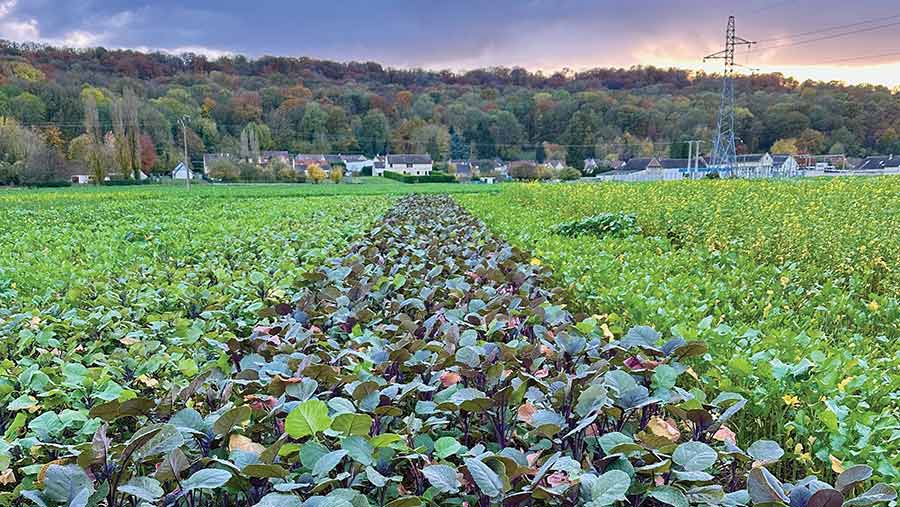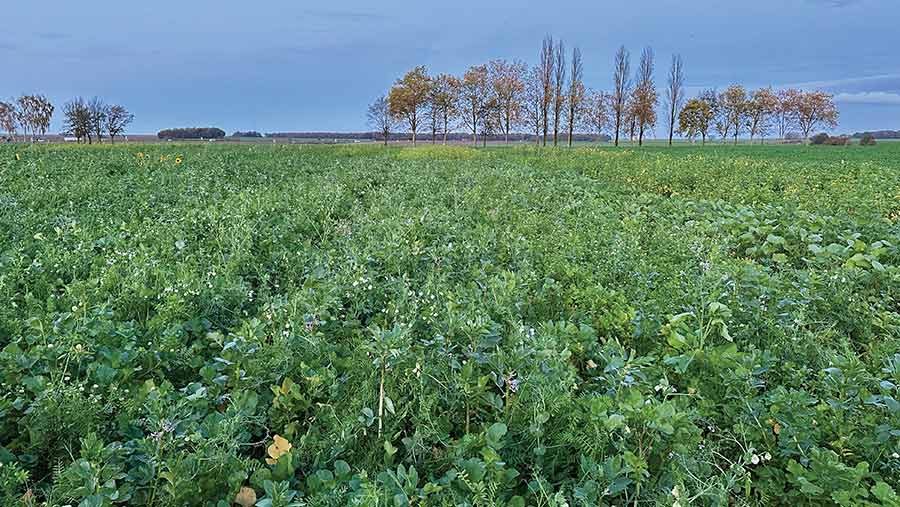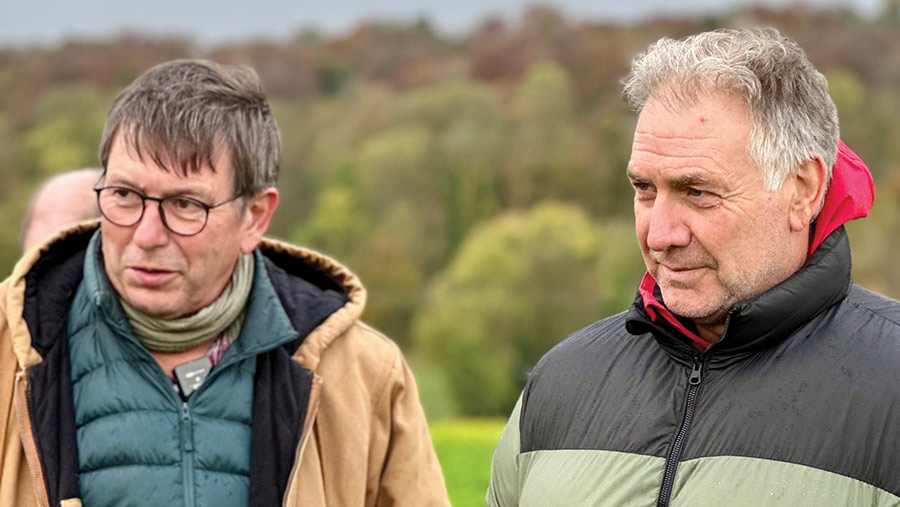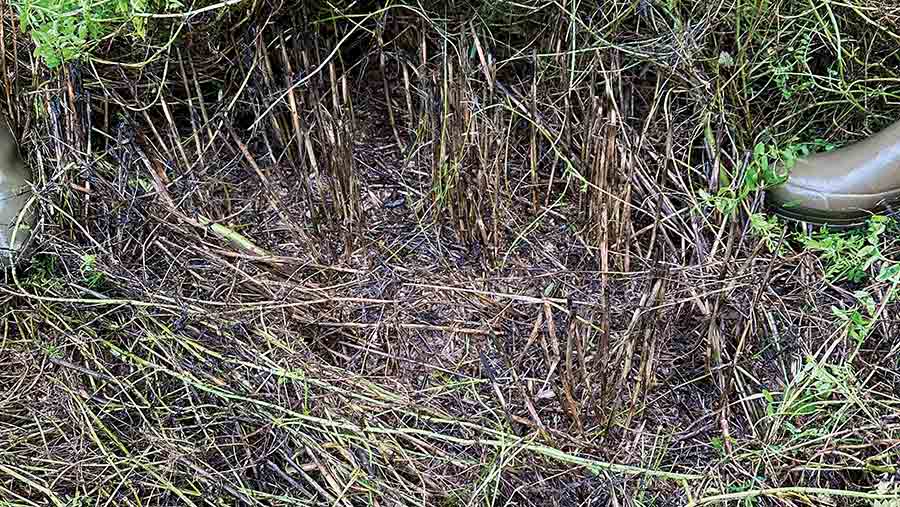What French cover crop trials are helping growers understand
 Egyptian mustard variety trial © Mike Abram
Egyptian mustard variety trial © Mike Abram Research into the best varieties of cover crop species, what seed rates to use and different establishment techniques are part of a 300 plot cover crop trials platform being run by the French co-operative, Agora, based in Oise, north-east of Paris.
Cover crops in France are compulsory following summer harvested crops, such as winter wheat and winter barley, to prevent soil erosion and reduce nitrate leaching, where land is left fallow over winter.
The crops typically must be left in the ground for at least six weeks following establishment. Destruction, depending on region, is usually allowed after 15 November.
See also: Cover crop study shows yield benefits of destruction methods
Those requirements are driving research into cover crops, explains Luc Vandeputte, head of Agora’s agronomy department.
As well as the platform site, the co-operative organises a further 150 field-scale cover crop trials in conjunction with farmers in a conservation agriculture group.

© Mike Abram
There are three main areas of focus for the trials at the platform site: comparisons of different varieties of the same species, investigations into multiple species mixes, including seed rate comparisons, and research into establishment techniques.
1. Cover crop variety trials
Just as there are differences in wheat or barley varieties, the same applies to cover crop species, Luc says. “We have seen quite large differences between varieties of the same species in terms of biomass, weed management capabilities and how fast they go to heading.”
In total, about 80 varieties of 10 species, including oats, mustards, phacelia, vetches and clovers, are being evaluated in the trials, which were established on 13 August.
Understanding the differences between varieties can help growers pick the best variety for their objectives.
For example, a late-flowering mustard such as SDF’s Simplex, which was the latest flowering mustard variety in the trial, might be better for growers looking to leave in a cover crop later.
Mustard is a popular choice for mandatory cover crops in France as it is cheap and easy to establish. Phacelia and berseem clover are the most popular additions where a more diverse mix is used.
Nutrient availability
Nutrient capture and subsequent availability to following crops can also vary, the co-operative has found.
Growers can use a tool, “Méthode d’estimation des Restitutions par les cultures intermediaries” (Merci), developed by the Regional Chamber of Agriculture in Nouvelle-Aquitaine, INRA and other partners to estimate the nutrients available for the next crop.
“It’s based on an enormous database,” Luc explains. “And according to how much green biomass you have in the cover crop, it evaluates how much nutrients you may have in your crop.
“This year we will make a lab analysis again of the carbon-to-nitrogen ratio of each variety because, last year, Merci gave the same result for each variety, but we could see it was different.
“When we did the analysis there was a seven-point difference between varieties of the same species and the evaluation system didn’t say any difference.”
2. Seed rate comparisons
In addition to the single-species variety plots, the co-operative is trialling about 40 different cover crop mixtures. In common with the single-species plots each will be assessed for biomass production, carbon-to-nitrogen ratio and weed burden.
The trial includes various mixtures at different seed rates. French research by Thierry Tétu is suggesting that cover crops are not being established at high enough seed rates to cycle nitrogen between two wheat crops, explains Frédéric Thomas, a French conservation agriculture consultant.
Higher seed rates will help the cover crop produce more nitrogen for the following crop while cycling carbon in the system, resulting in better cover crop growth, he says.
The high-density cover contained 30 seeds/sq m of beans, 75 seeds/sq m peas, 40 seeds/sq m fenugreek, 62 seeds/sq m hairy vetch, 200 seeds/sq m berseem clover and 20 seeds/sq m of forage radish, with comparisons between plots where the seed rates were reduced by 25% and 50%.
Triple nitrogen
“The research by Thierry suggests you can almost triple the amount of nitrogen by increasing the amount of seeds/sq m, but there will be a diminishing return.”
That appeared to be evident in the trial, where there was a much greater visual difference between the 50% plot and the 75% plot than between 75% and 100% high-density plots.

Frederic Thomas and Luc Vandenputte © Mike Abram
There has been debate over whether a dense cover crop that competes against weeds is better or worse than a more open cover, where weeds can more easily germinate and be sprayed off with glyphosate prior to the following crop being drilled.
But a dense cover will help more, Frédéric insists. “The grassweed will be more fragile with the cover crop, with reduced access to fertility, making it easier to kill with a herbicide.”
In a direct-drill system, seed predation will also play an important role in weed control, with shed seed perishing more quickly in a dense cover crop with increased biological activity, he suggests.
3. Establishment technique
As well as establishing cover crops following harvest of the previous crop, the co-operative is investigating whether broadcasting cover crop seed into a standing wheat crop has potential.
Earlier establishment potentially increases biomass, nutrient cycling and weed competition between crops, and could improve results before an autumn-sown cereal.
In the trial comparing 19 different cover crop species and mixes, the majority were broadcast using a spreader about 15 days before harvest at the milky ripe stage of the wheat. Three comparisons were also sown five days following harvest on 19 July.
“It’s been a good year for this technique,” Luc says. “We had a lot of rain in July and the best cover crop has produced about 7t/ha of dry matter, which is around 200kg/ha of nitrogen, of which about one-third will be available to the next crop.”
Weather is crucial for success, he notes. “This is the third year of conducting this trial. In 2021, it was good because of the wet summer, but in 2022 it was extremely dry and was much less successful, so you have to be a bit opportunistic.”
Timing is also important. “It has to be close to harvest with the moisture, but not too early as it will germinate and the shade from the crop can kill it.
“You need just the right time to ignite germination but with the plant barely establishing itself. Ideally, around 10 days before harvest seems optimum, while more than two weeks before you’re taking more risk.”
A surprising number of species seem to work well in the system. “Most cruciferae germinate, phacelia is not too bad, and surprisingly beans. Small seeds, such as hairy vetch, are very good, but sorghum doesn’t work so well.”
Technology
Seed technology can also improve success rates, with some seed companies using a clay-based pellet or “Fly” technology to improve ballistics, which allows the seeds to be spread up to 24m with a fertiliser spreader using similar setting as for ammonium nitrate fertilisers.

Weed-free ground under hairy vetch cover crop © Mike Abram
Earlier planting in this season’s trial has allowed, for example, Cerience’s Bledor mix of brown mustard, Massa hairy vetch and a purple vetch to trap 200kg/ha of nitrogen when established by broadcasting compared with 80kg/ha of nitrogen from post-harvest establishment.
That would equate to around 50kg/ha of extra nitrogen available to the following crop.
The mix is also very competitive against weeds. “It’s a very promising technique,” Luc suggests.
“Where we have a problem with resistant ryegrass, and underneath the vetch is clean – there are no ryegrasses and volunteers. By seeding before harvest it is a way to overcome volunteers and to manage some of the weeds.”

